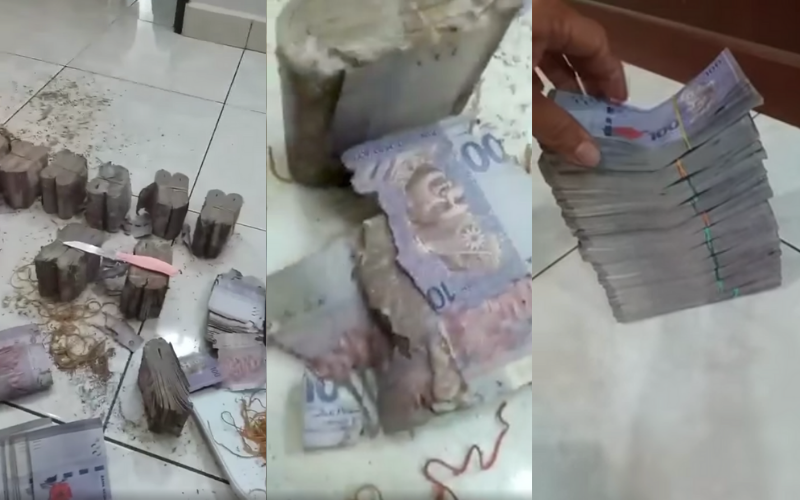Among the older generation, particularly for the Southeast Asian region, there tends to be some lingering distrust in financial institutions, or simply the unbroken habit of storing physical cash or gold in the house.
You can’t really blame them for the paranoia when they’ve probably been through the desperate times of war, or have faced the numerous financial crises that happened in 1985, 1997 and 2008.
Humans don’t have the best track record with their financial investments, let it be known.
The only few decades where financial institutions were stable was from the late 1940s to early 1970s, which was also known as the Golden Age in Europe, but before that, there were also two World Wars, separated by the Great Depression of 1929 to 1939 in between.
Yeah… Not the best times to be alive, admittedly.
Life Savings Destroyed by Pests and Erosion
On 1 December 2020, a Facebook user made a post in the Penang News Group to share the absolute tragedy that had happened to their Malaysian grandmother’s life savings due to an absent-minded error.
There were a total of four uploaded videos, each showing thick stacks of RM100 bills in varying stages of disintegration and damage.

The description of the post explained the situation, explaining how their grandmother stores her money in Milo tins—a popular product in the SEA region which is supposedly airtight—but the money ends up destroyed.


How Were The Banknotes Destroyed?
The original poster clearly wants to keep his anonymity as he is careful to keep his face out of view, but his voice and hand gives away his gender easily.
As he sorts through the ruined fortune, he tells the audience in a Chinese dialect about the damage done to the RM300,000 worth of bills.
It was mostly caused by pests and the notes degrading over the years.
There isn’t much information about what Malaysian banknotes are made out of, but most banknotes in the world are made from cotton paper, which may be mixed with linen, abaca, or other textile fibres.
In essence, the paper is made of cellulose—a repeating chain of glucose molecules—and paper quality is measured by how long the cellulose chains, and subsequently paper fibres, are.
The longer the paper fibres, the stronger, more flexible, and durable they are.
But paper fibres tend to shorten with age, and in the presence of moisture, acids in the environment, which can either be from air pollution or poor-quality enclosures, or simply acids that were already present within the paper from the manufacturing process, it can cause an acid hydrolysis reaction.
This, in turn, produces more acids, and feeds the continued degradation.
Besides acid hydrolysis, paper is susceptible to photolysis, which is damage by light and why paper turns yellow, or oxidative degradation.
Oxidative degradation is much more limited than acid hydrolysis though, but research has shown that cellulose itself generates acids as it ages, including formic, acetic, lactic and oxalic acids.
Of course, if good quality paper is stored in optimal conditions, with around 30% to 40% of relative humidity, they can be preserved for hundreds of years.
Therefore, the environment is an extremely important factor, and tin cans that used to store malt powder are decidedly not.
As for the pests, you can imagine that they somehow managed to slip through the gaps and started gnawing at the pulp of the notes.
Join our Telegram channel for more entertaining and informative articles at https://t.me/goodyfeedsg or download the Goody Feed app here: https://goodyfeed.com/app/
The Extent of Damage
In the videos, the damage done to the notes was quite severe, to the point where it disintegrated upon handling, or the legal tenders were destroyed beyond recognition.
Ergo, you can’t even go to the bank to replace them.
The rubber bands didn’t escape the consequence of time either, as they turned brittle, broke, and fell apart.
Fortunately, some of the stacks of Ringgit were still in good condition and could be salvaged.
Out of the RM300,000 fortune that was amassed over the year, approximately RM110,000 was saved.
It honestly hurts that nearly two-thirds were destroyed from neglect and improper storage, but at least a portion of the money remains intact.
If anything, this serves as a good lesson for anyone who has taken to storing their wealth in similar ways.
Please deposit them in the bank (preferably with higher interest rates), or exchange them into gold or silver bars instead, since pure metals are less likely to degrade over time, even if its value fluctuates.
There’s no need to put yourself through such financial heartbreak.
Read Also:
- Petition to Remove Johnny Depp’s Ex-Wife from Next Aquaman Movie Hits 3 Million Signatures
- YPs Made a Mess With Water & Ice-Cream in Punggol McD & Left for Elderly Staff to Clean Up
- Suspect in Bishan Murder Reportedly Kept Asking for Money As She Claimed to be a Scam Victim
- Ministers Spoke in Dramatic Video About Mental Health in S’pore
Featured Images: Facebook (Penang News Group)




